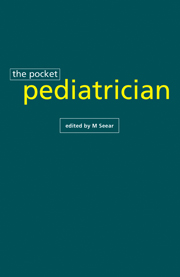Book contents
- Frontmatter
- Contents
- Analytical contents list
- Preface
- 1 Cardiology
- 2 Death and dying
- 3 Emergencies
- 4 Endocrinology
- 5 Fluids and electrolytes
- 6 Gastroenterology
- 7 General surgery
- 8 Health care ethics
- 9 Hematology
- 10 Infectious diseases
- 11 Intensive care and continuous infusion drugs
- 12 Medical genetics
- 13 Neonatology and neonatal drug dosage guidelines
- 14 Neurology
- 15 Nutrition
- 16 Oncology
- 17 Pediatric transport
- 18 Pharmacology and drug dosage guidelines
- 19 Renal
- 20 Resident fellow training
- 21 Respirology
- 22 Rheumatology
- 23 Transfusion medicine
- 24 Appendix
- Index
14 - Neurology
Published online by Cambridge University Press: 01 February 2010
- Frontmatter
- Contents
- Analytical contents list
- Preface
- 1 Cardiology
- 2 Death and dying
- 3 Emergencies
- 4 Endocrinology
- 5 Fluids and electrolytes
- 6 Gastroenterology
- 7 General surgery
- 8 Health care ethics
- 9 Hematology
- 10 Infectious diseases
- 11 Intensive care and continuous infusion drugs
- 12 Medical genetics
- 13 Neonatology and neonatal drug dosage guidelines
- 14 Neurology
- 15 Nutrition
- 16 Oncology
- 17 Pediatric transport
- 18 Pharmacology and drug dosage guidelines
- 19 Renal
- 20 Resident fellow training
- 21 Respirology
- 22 Rheumatology
- 23 Transfusion medicine
- 24 Appendix
- Index
Summary
SEIZURES AND EPILEPSY
An epileptic seizure is a clinical event related to a paroxysmal electrical discharge in the cerebral cortex. Many paroxysmal events in children are not epileptic seizures. It is important to distinguish these events from epileptic seizures because of differences in treatment and natural history. An accurate description of an episode from an eyewitness is important. Particular attention should be paid to the description of the setting, stimulus, prodrome or aura, onset, course, and termination of the event. Laboratory investigations are usually not helpful. An EEG is of limited value unless an episode is captured during the recording.
Paroxysmal nonepileptic events which mimic seizures:
Behavioral: daydreaming, aggressive outbursts, self–stimulation, psychogenic seizures.
Involuntary movements: jitteriness, rigors, tics, dystonias.
Anoxic ischemic events: reflex anoxic seizures, cyanotic and pallid breath holding attacks, syncope, migraine.
Sleep related: night terrors, sleep walking, enuresis, sleep myoclonus, narcolepsy–cataplexy, suffocation (Munchausen's syndrome), cardiac arrhythmias.
Vertigo.
Classification of epileptic seizures and epilepsies
An epileptic seizure is a symptom of underlying brain dysfunction. Optimal management of the patient requires an understanding of the underlying brain disorder. Determination of the seizure type (seizure classification) and the biological setting in which the seizure occurs (epilepsy classification) may suggest the nature of the underlying cause of the seizures. Seizure classification is based on the clinical features of the seizure and the EEG pattern both during and between seizures. In most patients, an ictal EEG recording is not obtained.
- Type
- Chapter
- Information
- The Pocket PediatricianThe BC Children's Hospital Manual, pp. 353 - 362Publisher: Cambridge University PressPrint publication year: 1996

